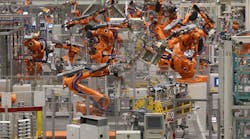Preparing for the Factory of the Future
The signposts are pointing the way: The Factory of the Future, where information technology (IT) and operational technology (OT) converge, is straight ahead and the road leading to it is a superhighway of technology, innovation, and advanced capabilities.
This four-part series examines the definition of the Factory of the Future, common characteristics, benefits, and how to get started.
Defining the Factory of the Future
The Factory of the Future has an evolving definition, even different names. Some call it Smart Manufacturing, Industry 4.0 or the Digital Enterprise.
While the terms vary, some elements are always in common. The Factory of the Future is the product of fast-changing disruptive technologies hitting manufacturing like a cyclone. Information technology and operational technology are both seeing drastic innovations. The convergence of these two forces is creating a paradigm shift. Manufacturing is experiencing the fourth industrial revolution.
We are already seeing results:
According to a report from SCM World, 40% of manufacturers they surveyed say that smart manufacturing along with its foundational technology—the Internet of Things—is within reach, and it’s the right time to invest.
Huffington Post reports that early adopters who have at least partially implemented smart manufacturing initiatives have documented measurable results:
- 82% reported increased efficiency
- 49% reported fewer product defects
- 45% reported customer satisfaction gains
The impact promises to grow and be even more substantial as manufacturers and their suppliers deploy and integrate more technologies across the entire manufacturing landscape. Greater speed, value, innovation, and closer alignment with demanding customers will be the new normal.
Analysts often cite the year 2020 as the next milestone moment. Some point to 2030 or 2050 as being the thresholds.
Find the Latest Internet-of-Things News, Trends and Best Practices
No matter which date you want to target, it is clear that substantial change is coming and coming fast. That future looks promising. Perhaps manufacturing will at last be able to leave behind the public impressions of labor-intensive, dirty and dangerous worksites, and bury once and for all the memories of plant closings and shipping jobs to low-cost countries, leaving communities devastated.
Manufacturing will be new again. We are on the way. According to the U.S. Department of Defense, nearly 900,000 new manufacturing jobs have been created since February 2010.
Disruptive technologies have been appearing on the horizon for several quarters now, starting to build the momentum and define the characteristics of the Factory of the Future, including:
- Social and mobile capabilities were some of the first next-generation trends that became must-have capabilities very quickly.
- Product configuration tools, integrated computer-assisted design (CAD) systems and late-stage assembly helped manufactures meet demands for mass customization.
- Robotics changed operational technology dramatically, just as shop-floor automation revolutionized workflows and production cycles.
- Big data started conversations about factories becoming predictive, leveraging analytics and creating strategies for identifying customer expectations.
- Cloud computing fueled the imagination further, making storage of immense pools of data possible.
- 3D printing launched a hype cycle that was—and still is—staggering.
- The Internet of Things far surpasses all of these disruptive technologies. The potential impact of the IoT is truly staggering and hard to grasp. While projections vary greatly, they are always described in trillions. McKinsey & Co. anticipates the global economic value to be $11 trillion, and Cisco predicts a $19 trillion opportunity.
This isn’t an absolute list, nor is there just one checklist of IT and OT tools that must be deployed to be considered a Factory of the Future. Some manufacturers will need more; some will be able to leverage two or three disruptive technologies to create a strong market position.
There is only one characteristic of the Factory of the Future that is essential: A creative mindset for problem-solving and out-of-the-box thinking is key to embracing new technologies—and reaping the rewards. Stubborn adherence to traditional processes—whether it’s holding onto a legacy ERP or insisting that IT modifications are necessities—will cause serious roadblocks.
Those who are already leading the way to modern manufacturing are making bold moves, unencumbered with outdated systems and legacy albatrosses. Are you ready to join their ranks?
Read Part II of Larry Korak's series on the Factory of the Future here.




